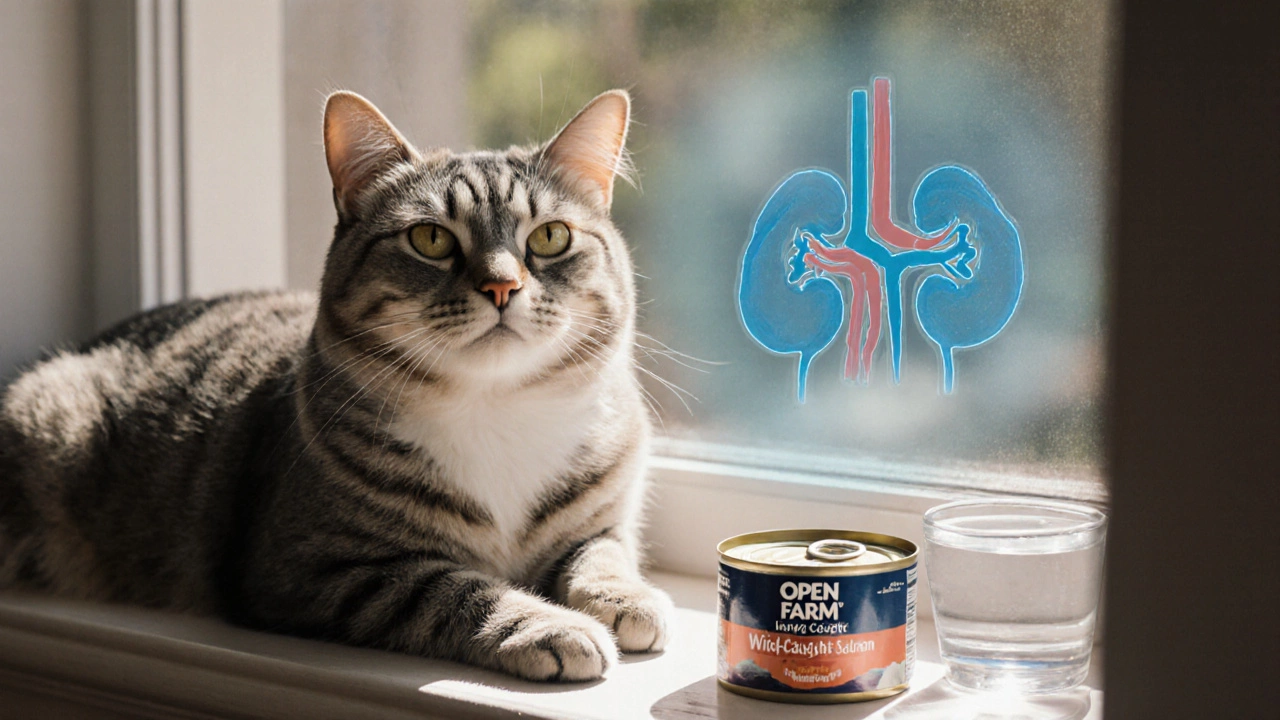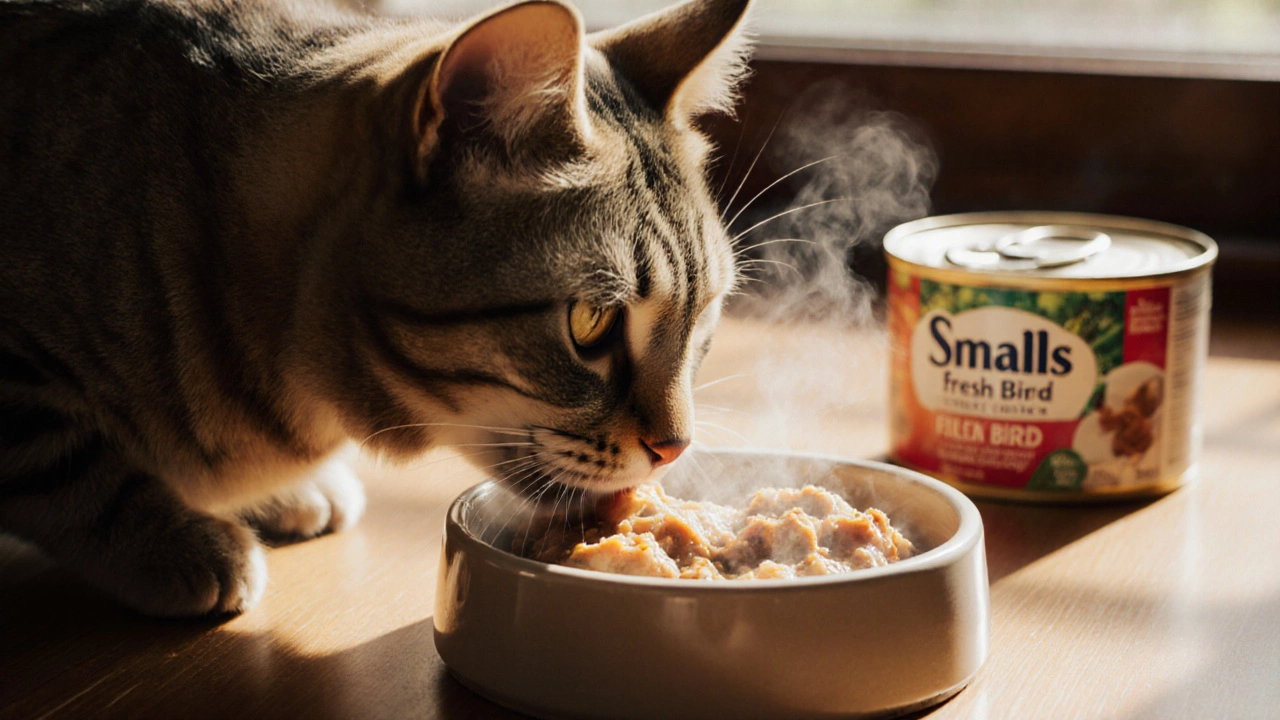Wet Cat Food Dry Matter Calculator
Calculate the actual protein and carbohydrate content of your cat's wet food. The article explains that wet food has 70-80% moisture, so the percentages on the label are diluted. This tool converts wet food percentages to dry matter values for accurate comparison.
For cats to thrive, wet food should have:
- ≥ 40% protein on a dry matter basis
- ≤ 10% carbohydrates on a dry matter basis
- Named animal protein as first ingredient
- No grains, fillers, or artificial additives
When you open a can of wet food for your cat, you want to know it’s giving them real nutrition-not just filler and fake flavors. With hundreds of brands on the shelf, how do you pick the healthiest wet food for cats? It’s not about price, branding, or cute packaging. It’s about what’s inside the can-and whether it matches what cats evolved to eat.
What Cats Actually Need to Thrive
Cats are obligate carnivores. That means their bodies are built to live on meat. Unlike dogs or humans, they can’t make certain nutrients from plants. They need taurine, arachidonic acid, vitamin A, and protein from animal sources. If their food doesn’t deliver these in the right amounts, they get sick-slowly, silently, and often too late.
Wet food is better than dry for cats because it mimics their natural diet. In the wild, cats get most of their water from prey. Dry food has less than 10% moisture. Even the best wet food has 70-80%. That’s huge for kidney and urinary tract health. A 2023 study from the University of California, Davis found that cats on wet food diets had 37% fewer lower urinary tract issues over a two-year period compared to those eating only dry food.
The Four Must-Have Ingredients in Healthy Wet Cat Food
Not all wet foods are created equal. Here’s what to look for on the label:
- Named meat as the first ingredient-like "chicken," "turkey," or "salmon." Avoid vague terms like "meat by-products," "poultry meal," or "animal digest."
- No grains or fillers-cats don’t need corn, wheat, or rice. These are cheap extenders that spike blood sugar and can trigger inflammation.
- High protein, low carbs-aim for at least 40% protein on a dry matter basis. Carbs should be under 10%. Many brands hide carbs in thickeners like carrageenan or potato starch.
- No artificial additives-no BHA, BHT, ethoxyquin, or artificial colors. These are banned in human food for a reason.
Check the guaranteed analysis on the back. Then do a quick math trick: if the moisture is 78%, subtract that from 100 to get the dry matter (22%). Then divide the protein percentage by 0.22. For example: 10% protein on a wet basis = 45% on a dry matter basis. That’s good. If it’s only 8% protein, that’s 36% dry matter-and too low.
Top 5 Healthiest Wet Cat Foods (2025 Edition)
Based on ingredient quality, veterinary recommendations, and real-world results from cat owners, here are the top five wet foods that actually meet biological needs:
| Brand | Primary Protein | Protein (Dry Matter) | Carbs (Dry Matter) | Key Features |
|---|---|---|---|---|
| Smalls Fresh Bird | Chicken & Turkey | 52% | 5% | Human-grade, delivered fresh, no preservatives |
| Weruva Paw Lickin’ Chicken | Chicken | 48% | 6% | Grain-free, no carrageenan, high moisture |
| Thrive Freeze-Dried Raw (rehydrated) | Beef & Chicken | 55% | 3% | Freeze-dried raw, reconstituted with water |
| Open Farm Wild-Caught Salmon | Salmon | 46% | 7% | Sustainably sourced, no antibiotics, added taurine |
| Instinct by Nature’s Variety Grain-Free | Chicken | 44% | 8% | Available in tubs, no gums or thickeners |
Smalls Fresh Bird leads because it uses whole, human-grade meat with no processing beyond gentle cooking. Weruva is the most consistent budget-friendly option with zero controversial additives. Open Farm stands out for ethical sourcing. If your cat has sensitive digestion, Thrive’s raw-rehydrated format is often the most digestible.

What to Avoid at All Costs
Some wet foods look healthy but are full of hidden traps:
- Carrageenan-a thickener linked to gut inflammation in cats. Found in Weruva’s older formulas (check labels; they’ve phased it out in most).
- Guar gum, xanthan gum-used to thicken, but can cause diarrhea and gas.
- Fish-heavy diets-tuna or salmon as the only protein? Risk of mercury buildup and thyroid issues over time. Rotate proteins.
- Added sugars-yes, some brands add molasses or sweet potatoes for flavor. Cats don’t taste sweetness, but they still metabolize the sugar.
- “For all life stages”-this label means the food is balanced for kittens, adults, and seniors. But senior cats need less protein and more joint support. A one-size-fits-all formula rarely works.
One owner in Auckland switched her 12-year-old cat from a popular brand with carrageenan to Weruva. Within three weeks, her cat’s vomiting stopped and her coat became shinier. No vet visit needed. Just better food.
How to Transition Your Cat to a Healthier Wet Food
Don’t dump the old food and replace it overnight. Cats hate change. Here’s how to do it safely:
- Start with 25% new food, 75% old food for 3 days.
- Move to 50/50 for another 3 days.
- Then 75% new, 25% old for 3 more days.
- Full switch on day 10.
If your cat refuses to eat? Warm the food slightly-cats prefer food at body temperature. Add a splash of low-sodium chicken broth (no onion or garlic). Try different textures: pâté, shreds, or chunks. Some cats prefer gravy. Others want solid pieces.

Special Cases: Senior Cats, Diabetic Cats, and Cats with Kidney Disease
Not all healthy wet foods work for every cat.
Senior cats (over 10 years): Need high-quality protein to maintain muscle, but lower phosphorus to protect kidneys. Open Farm and Smalls are good choices. Avoid foods with added calcium phosphate.
Diabetic cats: Must have ultra-low carbs. Thrive and Smalls are ideal. Many vets recommend feeding only wet food to diabetic cats. One 2024 study showed 60% of diabetic cats went into remission within six months on a low-carb wet food diet.
Cats with kidney disease: Need controlled phosphorus and sodium. Look for foods labeled "renal support" and avoid those with added salt or bone meal. Hill’s Prescription Diet k/d is vet-recommended, but if you want a non-prescription option, try a low-phosphorus version of Open Farm or Instinct.
Final Rule: Feed What Your Cat Needs, Not What’s Trendy
There’s no single "best" wet food for every cat. What works for one might cause digestive upset in another. The healthiest wet food for your cat is the one that:
- Has real meat as the first ingredient
- Has no grains, gums, or artificial junk
- Keeps carbs under 10%
- Your cat actually eats and thrives on
Don’t chase trends. Don’t buy based on Instagram ads. Watch your cat’s weight, energy, coat, litter box habits. If they’re bright-eyed, active, and pooping regularly-your food is working.
Switching to the right wet food can extend your cat’s life. Not by years. By quality. Every meal matters.
Is wet food better than dry food for cats?
Yes, for most cats. Wet food has 70-80% moisture, which helps prevent urinary tract issues and keeps kidneys healthy. Dry food has less than 10% moisture and often contains fillers like corn and wheat that cats don’t need. Cats evolved to get water from prey, not a bowl. Wet food mimics their natural diet.
Can I mix wet and dry food?
You can, but it’s not ideal. Mixing high-carb dry food with healthy wet food dilutes the benefits. If you want to offer variety, feed wet food as the main meal and use dry food only as an occasional treat-or skip dry entirely. Cats on all-wet diets tend to be leaner and have fewer health issues long-term.
How much wet food should I feed my cat?
Most adult cats need 2-3 cans (3 oz each) per day, split into two meals. But it depends on weight and activity. A 10-pound cat needs about 200-250 calories daily. Check the calorie count on the can-some are 70-80 kcal per ounce, others are 100+. Feed based on calories, not cans. If your cat gains weight, reduce portions. If they’re too thin, increase.
Are grain-free wet foods better for cats?
Yes, because cats don’t need grains. They’re carnivores. Grains like corn, rice, and wheat are used as cheap fillers and can trigger allergies or blood sugar spikes. Grain-free doesn’t automatically mean healthy-some grain-free foods replace grains with potatoes or peas, which are still carbs. Look for low-carb, meat-first formulas instead of just "grain-free" on the label.
What should I do if my cat won’t eat wet food?
Warm it up to body temperature (microwave for 5 seconds). Try different textures-pâté, shreds, or chunks. Add a sprinkle of freeze-dried chicken or a drop of tuna juice (not oil). Be patient. Some cats take weeks to adjust. Never force-feed. If your cat refuses food for more than 24 hours, contact a vet-cats can develop liver damage quickly if they stop eating.
